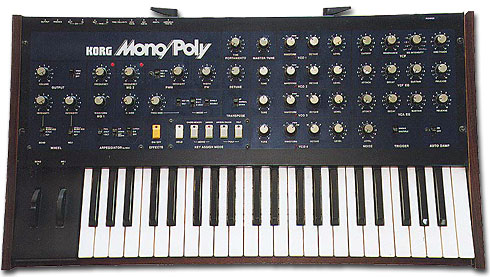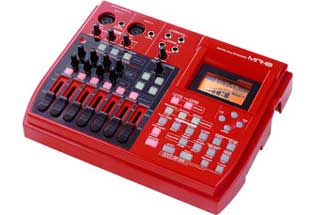
|

|
The Korg Mono/Poly

The Korg Mono/Poly was released in 1981, and it would soon go on to be a tremendously popular synth. Many claimed
that it was Korg's answer to the Sequential Prophet 5, and this is obvious if you compare the two synths, both in terms of
look and sound. I was lucky enough to recently get my hands on one of these beasts, and I have been consistently impressed
with it. It has that huge classic analogue sound that is so typical of synths from that period. It has 4 VCOs,
portamento, CV/gate control, white noise, a VCF filter section, pitch/mod wheels and an awesome arppegiator. In
fact, the arppegiator is probably my favorite feature. It sounds great, and can even be synched to an external source.
There are also effects, and the resonance and cutoff knobs just cry for twiddling. I still have not explored all the
ins and outs of this synth, but I have a feeling I will get lots of enjoyment out of it. I am also told that you can
get a converter that will adapt a MIDI signal to the old CV/gate signal, so I am anxious to give that a try. This is
a husky, versatile synth that can produce a wide array of sounds!
The Roland JV 1010 Sound Module

The JV 1010 is by no means a current piece of technology. It was first manufactured by Roland in 1999. Yet, despite the
fact that this sound module is practically a decade old, the sounds that can be found within can still pack a punch. A few
years ago I was looking for a sound module that would give me three basic criteria: 1. great piano sounds, 2. excellent string
sounds and 3. modern and fresh techno/dance sounds. The JV 1010 delivers all three in abundance. Seriously, the first time
I heard the orchestral string sounds, I was amazed. So lush and full sounding. I swore I had a 12 piece orchestra in my
bedroom studio. And the piano sounds are very usable as well.
In the synth bank, there are many expressive synth bass sounds, as well as a plethora of synth pads and lead lines. I
did notice that most of the sounds do have a distinctly "Roland" characteristic. Some sounds are decidedly analogue,
while many have more of a modern sheen. The guitar sounds are very convincing as well. Acoustic guitars are mostly pleasant,
and the electric guitars are probably some of the most convincing I've ever heard produced synthetically. There's really
nothing negative I can say about the actual quality of the sounds. They're extremely top-notch. And the sounds are fully
editable, so you can fine-tune them until you are completely satisfied.
There are also some "pulsating" noises which are very good for soundscapes and techno music. There is actually
no shortage of atmospheric type sounds and sound effects, which are handy for numerous home recording applications. The JV
1010 was also issued with a library of numerous soundcards, which makes the module expandable and gives you even more sounds.
Soundcards released included orchestral, ethnic, and several others. Plus, the JV 1010 features some very good rhythm sounds,
which can be used through channel 10 on a sequencer. The drum sounds range from rock to dance to everything in between.
My only real complaint about the JV 1010 is the great differentiation in volume levels between sounds. It is often extremely
varied. For example, if you are on patch 38 in the synth bank, and you change to patch 39, the volume will either decrease
or increase enormously. This is not always the case, although it is frequent enough to warrant annoyance. Plus, I noticed
this can be a real issue when you are trying to get a multi-timbral performance out of the JV 1010. Yes, you can adjust the
individual volume of each separate sound, but not a great deal. Certainly not enough to compensate for this issue.
Overall, if you are looking for a great quality sound module that is easy to use, inexpensive and still can hold its own
against more up-to-date machines, the JV 1010 is for you. It would make a welcome addition to any home studio.
The Fostex MR8 Digital Multitracker

I got my hands on an MR8 a while ago. I had heard that it was the flagship for a whole new breed of digital multitrackers
that were now being offered at never before seen low prices. Plus, this new breed of multitracker was also being hailed for
its portability and its ease of use. For years I had been using a Fostex cassette four track, and it had done me well, but
I felt it was time to move into the digital era. The clean and crisp quality of digital was very appealling ot me.
Overall, I would highly recommend this machine to anyone who wants an entry level digital multitracker. It is very intuitive,
and the layout of the buttons makes it easy to get used to. Of course, it's not perfect, and I do have a few qualms with
it that I will share below. It does come with MIDI, however I must admit that I still have not used the MIDI function and
I am totally unfamiliar with how dedicated it is.
Here, then, is a quick list of the Pros and Cons I found with this machine:
Pros: Very easy to use, LCD screen very easy to read, manual was quite user friendly, buttons light up; making it very
easy to use in subdued lighting, light and portable, has an Amp and Microphone emulation feature which provides interesting
effects, digital out for the cleanest possible mixdown, mastering effects are useful, has two headphone jacks, inputs can
be 1/4 inch or XLR, very high quality recordings for a good price, attractive red casing.
Cons: Flash Card technology...even a 512MB card can fill up ever so quickly (even if you are only using "extended"
mode). When hitting stop button, it takes a second for the playback to actually stop. Noticed a slight degradation in sound
(?) when jumping tracks. Echo and delay effects are somewhat weak. There are only pans on tracks 1-4. WAV file conversion
can only be done when doing a submix to tracks 7 and 8. Can't do a direct mix to digital if the song was recorded in "extended"
mode. When fader is brought down to zero, the last few notches before zero are not gradual, bringing the volume to silence
very abruptly.
|

|

|
